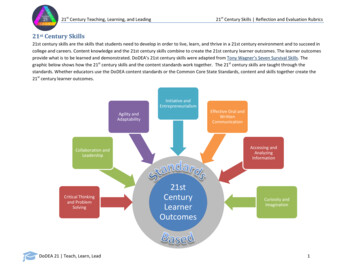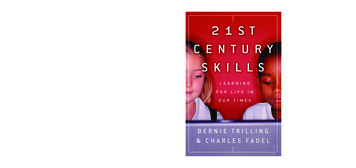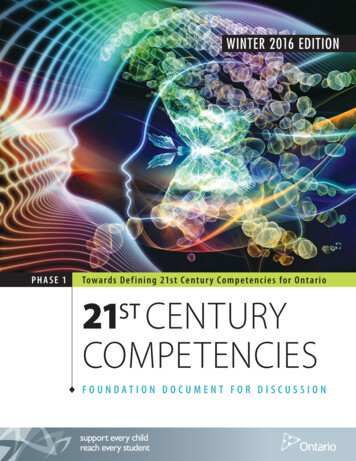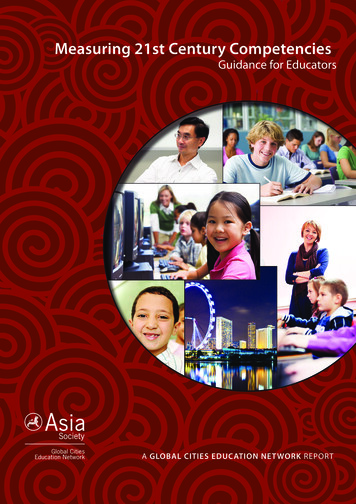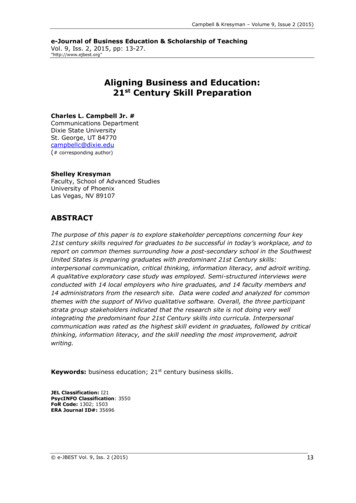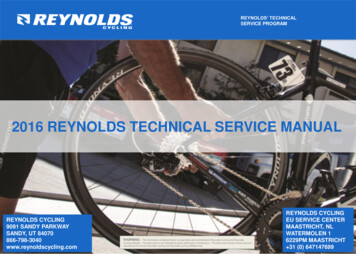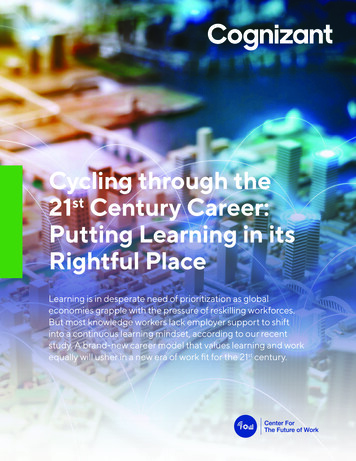
Transcription
Cycling through the21st Century Career:Putting Learning in itsRightful PlaceLearning is in desperate need of prioritization as globaleconomies grapple with the pressure of reskilling workforces.But most knowledge workers lack employer support to shiftinto a continuous learning mindset, according to our recentstudy. A brand-new career model that values learning and workequally will usher in a new era of work fit for the 21st century.
Executive SummaryThe worker’s relationship with learning is broken.Until we enter the workforce, learning is integrated into everything we do. At school, thepupil’s homework is learning. At university, the student’s coursework is learning. But inthe office, the worker’s work has nothing to do with learning at all.With fast-changing skills and longer career spans, however, learning today should beconsidered just as important as work itself. As a well-known World Economic Forumreport points out, more than 35% of important job skills will change between 2016 and12020, and this pace won’t slow down any time soon. What’s more, careers are extendingas expected lifespans rise, resulting in an even greater need for a continuous skillsrefresh. Learning is the fuel for modern work and fulfilling careers that stand thetest of time.To better understand the barriers hindering adoption of a continuous learning mindset,we conducted a study of 1,000 knowledge workers across Europe. While the study wasEurope-centric, our findings are relevant to workplaces globally (see methodology,page 28). As it turns out, a predominant issue with workplace learning is its lackof relevance to the actual work being done: Concerningly, one out of every threerespondents said learning has little or no impact on their work.To close this gap and address other issues that arose in our findings, it’s vital tounderstand what is driving this disconnect and what learning & development (L&D)professionals (with the support of business leaders) can do about it. We uncovered threekey challenges: The workforce needs support making the connection between emerging skills andtheir work. Organizations, however, promote the prioritization of work over learning, spurringworkers to focus only on the bare minimum to meet learning mandates. The traditional linear career model of learn-work-retire is stalling the adoption ofcontinuous learning as it effectively encourages workers to ditch education when theystep through the office door.By unpacking the outdated career model and analyzing respondents’ top-rankedrequests for a new-and-improved approach to learning, we’ve developed a brand-newcareer model fit for the 21st century, as well as a framework for achieving it through thethree Ms: measurement, motivation and mobility.October 2019
Our key takeaways: Knowledge workers are blind to the problem – it’s time for a wake-up call. The majority of workers inour study (65%) don’t see the need to upskill. The workforce needs support from employers to adopt acontinuous learning mindset – they must first understand why, and then focus on how. Workers need to understand learning’s relevance to work. A total of 43% of respondents believetheir learning has only a moderate impact on their work. Over one-third (34%) say there’s limited impact– or none at all – on work. This has to change. In order to answer the question, “Why adopt a continuouslearning mindset?” business leaders need to focus on better integrating learning and work. Employees are turning to employers for support – but finding the well dry. The majority of workersin our study (73%) depend on their employer for support in preparing for the future of work. Despite this,over half are concerned about their employers’ ability to do so. To step up their game, employers needto help workers become adaptable. Rather than confining workers to one job role, employers shouldpromote a task-based view of work and support movement across units, departments and teams. Better integration of learning and work demands a better L&D structure. The majority of L&Ddepartments operate in a silo, with little input from the rest of the business and little alignment with2business strategy, according to our recent report “Relearning How We Learn.” Organizations need tomake it a dual responsibility of strategy leaders and L&D to ensure learning is in line with the changingworld of work. Let the data guide the way. To shift toward a modern career model, organizations need to harnessemployee data, focusing foremost on measuring learning against job performance. Only 15% ofrespondents say their employer is doing this today. Most workers approach learning as a must-do, not a want-to-do. We analyzed a variety of responsesin our study to create learner profiles for each respondent. The results were disheartening – more thanhalf of respondents (51%) can be considered “compliant learners,” who undertake training only to meetperformance goals. Very few respondents learn because they consider it important for professionalgrowth (27%), and even fewer learn for the love of learning (22%). It’s imperative that learning be maderelevant to work. It’s all about me, me, me. Organizations must provide learning experiences that are data-driven,relevant and personalized. This is the core of our Three M methodology.To shift toward a modern career model, organizationsneed to harness employee data, focusing foremost onmeasuring learning against job performance.Cycling through the 21st Century Career: Putting Learning in its Rightful Place /3
CURRENTLEARNINGMODELS AREBROKEN4/Cycling through the 21st Century Career: Putting Learning in its Rightful Place
Whether a digital native or a digital nomad, every knowledge workeris confronted with the same rapid pace of change unique to the digitalage and the subsequent urgent need to adopt a continuous learningmindset. The spotlight on this issue has been well-and-truly switchedon; our LinkedIn news feeds are clogged with rundowns of the “top 10skills of the year” or predictions for next year.But readers of such lists are often left wondering what (if anything) this has actually got to do with theirwork, and who (if anyone) is keeping up. Why would a marketing manager need to be highly skilled inartificial intelligence (AI)? Why would an accountant need UX design skills? It’s all too easy to shrug, say,“This won’t impact me,” and carry on doing the same-old-same-old.This seems to be the mindset of the majority of knowledge workers, according to our study. Mostrespondents think they’re exempt from upskilling, with 65% expressing confidence that their currentskillset will sustain them throughout their career (see Figure 1). This confidence actually increases with thelength of the career ahead, with millennials scoring above-average results for “very/extremely confident.”Misplaced confidence in current skillsetHow confident are you that the skills and knowledge you have today will serve youthrough your long-term career?45%40%35%30%25%20%15%10%5%0%Not at allconfidentSlightlyconfident25-34 yearsModeratelyconfident35-44 yearsVery confident45-54 yearsExtremelyconfident55-64 yearsBase: 1,056 respondentsSource: Cognizant’s Center for the Future of WorkFigure 1Cycling through the 21st Century Career: Putting Learning in its Rightful Place /5
While not every employee will need to build advancedalgorithms like the engineers at DeepMind, most jobs –75% of them, according to our recent research – will beaugmented by automation and AI, and 13% of new jobs inthe future will be created by these technologies. It’s vital thatworkers gain at least a high-level understanding of these newtechnologies and how to work alongside them.Workers seem to need support connecting the dots between fast emerging skills and their own work.AI (often found at the top of current and emerging top-skills lists), for example, should be on everyone’sagenda. While not every employee will need to build advanced algorithms like the engineers at DeepMind,most jobs – 75% of them, according to our recent research – will be augmented by automation and AI,and 13% of new jobs in the future will be created by these technologies.3 It’s vital that workers gain at leasta high-level understanding of these new technologies and how to work alongside them. (To learn moreabout why marketing managers must know about AI, see our report “21 Marketing Jobs of the Future.”4)Workers are struggling to find this connection between learning and work, however, and that makes it veryeasy for them to deprioritize learning. If a large proportion of respondents (43%) believe their learning hasonly a moderate impact on their work (see Figure 2), and 34% go so far as to say there’s limited impact – ornone at all – on work, what motivation is there to learn new skills? Why would they give up precious time tolearn something with no bearing on their performance?The work-learn disconnectWhat impact do you think training has on your job?3%6%23%25%43%No impactVery limited impactModerate impactSignificant impactBase: 1,056 respondentsSource: Cognizant’s Center for the Future of WorkFigure 26/Cycling through the 21st Century Career: Putting Learning in its Rightful PlaceLimited impact
Not only is the importance of learning misunderstood by employees, but employers are also offeringinadequate support for adopting a continuous learning mindset. For nearly three-quarters of respondents(73%), the employer was the number-one go-to for information on how work is changing, compared withonly 7% relying on governments and 4% on academic institutions. And yet over half of respondents voicedconcern about their employer’s ability to do so. It’s time for L&D professionals to rethink how learning works.VR education experiences won’t fix the problemIt’s tempting for L&D professionals to turn to new delivery models such as virtual or augmented reality,social learning platforms or micro-learning techniques to encourage a new learning mindset. Accordingto our “Relearning How We Learn” report, the percentage of business leaders using AR/VR learningtechnologies will grow from 19% today to 68% in five years.5However, these types of fixes don’t fully address what workers say would help them learn more effectively,such as dedicated time at work for learning, and more personalized learning that’s aligned with theircareer path (see Figure 3). These sentiments highlight a sense of frustration among the workforce: What’slearning got to do with me? How can I find the time to learn when the 9-5 is devoted solely to “work”? Howcan learning help me stay employable over a 40-, 50-, 60-year career?New methods of learning delivery, meanwhile, ranked in the bottom half of responses in our study. Whileimportant, overhauling the method of delivery won’t solve the deeper, structural issues blocking learningfrom being effective.How to inspire continuous learningWhat would help you learn more effectively?24%1Having more working hours devoted to training2Learning that is personalized for me and my needs3Better alignment between training and career paths4Integrating real-time learning into the workflow8%5Understanding how the training is relevant to my work8%6Content being better organized/more easily searchable7Microlearning: shorter, bite-sized, learning options8Multiple delivery channels and format (mobile, desktop, video, etc.)9The availability of social learning platforms3%The use of augmented and virtual reality3%1023%12%7%6%5%Base: 1,056 respondentsCognizant’s Center for the Future of WorkFigure 3Cycling through the 21st Century Career: Putting Learning in its Rightful Place /7
Structural disconnects between learning and workTo address these issues, organizations need to look internally at their own structural approach to learningand development. In “Relearning How We Learn,” we found that L&D practices are stuck in a silo: 60% ofbusinesses agreed that learning strategy is the responsibility of the L&D and/or HR department alone, withlittle input coming from the rest of the business.While the chief learning officer’s (CLO) primary responsibility should be to align business strategy withworkforce learning and development, organizations today are slow to promote CLOs. Nearly every Fortune500 company has someone in charge of L&D, but rather than a C-suite position, they’re more likely to be a6“head of L&D” or a “training director.”Organizations need to overhaul their approach to learning across the board, not just within the L&D and/or HR silo. This must start with business leaders from across the board taking greater responsibility forlearning programs, working together with the CLO to create development plans that align the workforcewith the strategic direction of the company (see Quick Take, page 20).Updating the concept of ‘career’It’s not just the structure of the organization that reinforces the disconnect between learning and work; it’salso the structure of the individual’s work life.Easily identifiable by a 40-hour, five-day work week, the current career model is the product of the SecondIndustrial Revolution, and came into force over a century ago. Robert Owen, one of the 19th centuryfounders of the cooperative movement, marketed his radical idea with the slogan, “Eight hours’ labor, eighthours’ recreation, eight hours’ rest.” Today, a catchier slogan might be Dolly Parton’s “Working 9 to 5.”This career model promotes a learn-work-retire cadence, encouraging workers to give up any meaningfullearning as soon as they step through the office door. This might have made sense when the pace ofchange was slow enough for one set of skills to last a lifetime, but that’s not the case today.We’ve identified five additional traps that stunt learning at work (see Figure 4, next page).It’s not just the structure of the organization thatreinforces the disconnect between learning and work;it’s also the structure of the individual’s work life.8/Cycling through the 21st Century Career: Putting Learning in its Rightful Place
The traps of the outdated career modelRestrictive job roles. Workers currently consider their work within the confines of aspecific job role: “I am a nurse,” “I am an IT consultant.” Rather than branching out inexperience and learning, they become increasingly mechanical in the way they executethe same tasks over and over, throughout their career.One-way streets and linear hierarchies. Restrictive job roles are further reinforced by linearhierarchies, which are still the norm. Consider a colleague or friend who makes a sidewaysmove to more meaningful work for the same pay – would you celebrate in the same way as ifit were a promotion? Learning and development can’t even keep up with linear hierarchies,despite their being ingrained in work for decades. For example, only receiving managementtraining after you’ve become a manager is common across many organizations.Working 9-5. The majority of workers are still confined to the 9-5 and are programmed tobelieve that these 40 hours a week are for work only. But research reveals that actual timespent working is more like three hours a day and that workers fill up their remaining hours notwith learning but with unrelated activities: reading news websites (on average, 65 minutes aday), checking social media (44 minutes a day) and talking to colleagues about non-work7related topics (40 minutes a day). Workers seem unaware that these extra 2.5 hours of theworkday could be put to better use; in our study, the number-one barrier to continuouslearning was a lack of time.“But that’s how it’s always been done.” As is the case for many workers, “working for theman” means doing your time in exchange for a paycheck. No more, no less. Finding truepurpose in work is not the reality for most; in fact, some studies show most businesses8don’t even define a collective purpose. There’s still very little incentive to learn anddevelop beyond the confines of a restrictive job role.One-size-fits-all. Customer experience (CX) today is often so personalized that userswonder whether their devices are somehow listening to them – because how else can9Instagram surface such relevant ads? The employee experience, however, doesn’t evencome close to being as personalized and relevant. This is also an issue on the learningfront: The second highest rated barrier to learning identified in our research was a lack ofrelevance of learning materials for individuals and their work.Source: Cognizant’s Center for the Future of WorkFigure 410On a positive note, some of these traps are starting to regress. For example, software developers oftenfocus on project-based work adopting Agile methodologies, and a number of small companies across the11UK have adopted the four-day work week, some claiming a subsequent 30% increase in productivity.But steps in the right direction are not widespread, especially in larger organizations, which can be slowerto overhaul traditional operational practices.Learning, by now, should be considered just as important as the work itself. Indeed, learning is the fuel formodern work and fulfilling careers that stand the test of time.Cycling through the 21st Century Career: Putting Learning in its Rightful Place /9
KEEP CALM ANDCAREER ON:INTRODUCINGTHE MODERNCAREER MODEL10/Cycling through the 21st Century Career: Putting Learning in its Rightful Place
We’ve designed a model of the modern career, based on a cyclical relationship between learning and work. Inour model, work is broken down into smaller parts – tasks – into which learning is fully integrated, (see Figure 5).Updating the career-learning mindsetFrom the outdated career model Old career modelKaren SmithSenior Manager – Technology DivisionInboxTodayCommunications Meeting scheduled[External ]Karen SmithSenior Manager – Technology Division Marketing Can we reschedule[Internal]MeetingsCalendarOn the agenda Review Confirming[Internal] Ideas Seminar presentations[Internal]To-DoMeetingsTo-DoTo-DoTask ListTask List1. Research technology vendors and make recommendation2.strategypresentationedit makeslides/content1. FinalizeResearchtechnologyvendors- andrecommendation3.data for productand write up2. AnalyzeFinalizeconsumerstrategy presentation- editlaunchslides/content4.Finishbudgetappraisal3. Analyze consumer data for product launch and write up5. Write blog for this month4. Finish budget appraisal6. Direct-report year-end appraisals5. Write blog for this month7. Connect with marketing team re. upcoming6. speakingDirect-reportyear-end appraisalsengagement7. Connect with marketing team re. upcoming speaking engagementNew Notification: Youhave two mandatorylearning courses tocomplete by year end.Click here to the modern career model NotificationsYou’ve been assigned a new cycle!DashboardJust nowYou’re fully upskilled for cycle #12. Congrats!Active Cycles Inactive Cycles Past Cycles2 days agoClick here to see your learningimpact score for this month.Last weekKaren SmithNumber ofactive cycles15DashboardProfileCareer pathwaysComplete course:effective written communicationOpen opportunitiesAnalyticsMake ch technologyvendorsAttend conferenceSource: Cognizant Center for the Future of WorkFigure 5Cycling through the 21st Century Career: Putting Learning in its Rightful Place /11
The core component of the modern career model: the cycleIn the modern career model, each worker considers his or her career not as a series of projects on theone hand and learning goals on the other but as a series of cycles in which the two are intertwined andinterrelated (see Figure 5, previous page). This cyclical relationship implies that the impact of learning onwork is considered just as important – and demands just as much attention – as the impact that emergingwork has on learning.A cycle can be initiated, for example, by an emerging task need within the organization. As a new taskemerges, learning is aligned. For example, someone with the task of building a people analytics capabilityin the organization might start by engaging with learning resources, such as “Data Analytics in HR” or “AnIntroduction to Organizational Network Analysis.”As the task is undertaken, the L&D leader tracks how effective the learning is, in relation to the work beingdone. For example, a relevant metric might be increased speed and accuracy. More learning can berecommended to fine-tune progress as gaps are assessed.Instead of learning once, at the onboarding stage of a new project, continuous learning ensures thefunction remains agile, on the cutting edge of best-in-class and keeping up with the pace of change. Thisis particularly true as new technologies impact job functions. Consider our example of building a peopleanalytics function and learning about organizational network analysis (ONA). While ONA can introducebountiful opportunities to understanding how work actually gets done (not often revealed on the staticorg chart), many organizations struggle to integrate the technology and find appropriate uses. Successwith ONA would be more likely if organizations took a continuous learning approach, operating in a cycledmanner rather than a one-off course that isn’t integrated with the actual work.In the modern career model, eachworker considers his or her careernot as a series of projects on the onehand and learning goals on the otherbut as a series of cycles in which thetwo are intertwined and interrelated.12/Cycling through the 21st Century Career: Putting Learning in its Rightful Place
Matching cycles to individualsAnother key component of the modern career model is a deeper level of personalization and relevance.When work is broken down into smaller component parts (or cycles), workers are no longer restricted bypre-defined job roles that leave little room for taking on new tasks outside their remit.By collecting robust data on individual goals, motivations and learning preferences, as well as skillsets andjob performance, L&D teams can match people with cycles that suit their interests and strengths.At its most agile, this new model should facilitate the fluid movement of the workforce across teams anddepartments. One cycle might sit in marketing, and another cycle might sit in the business intelligencedepartment. This fluid movement would not only ensure an agile workforce; it would also expandlearning and development opportunities and – when personalized –increase employee engagement andsatisfaction by connecting individuals with work they’re excited about.In summary, the main features of the modern career model are: Within each cycle, learning is indivisible from work. Proactive, personalized matchmaking occurs between individuals and cycles. The transition between cycles is fluid, as learning is prioritized by the needs of the organization and thewider digital economy.Only when we consider learning as an integral part of every cycle will it achieve the same status as work andbecome truly continuous.Cycling through the 21st Century Career: Putting Learning in its Rightful Place /13
Quick TakeWhose job is it?It is mission critical for organizations to take responsibility for updated learning anddevelopment for the entire workforce, not just senior executives. Without learningopportunities for all knowledge workers, the workforce is heading toward a destructivesegmentation between top-tier knowledge workers and blue-collar work, with “lowertier” knowledge workers left in a work no-man’s land as machines do (more and more of)everything.Ultimately, a collaborative effort between business, government and academia is what itwill take to address the urgent global reskilling need.At the center of this collaboration sits the individual. It is expected that knowledgeworkers assume agency for their careers. Thankfully, of the workers surveyed here,63% agreed they were responsible for their own learning and development. However,individuals still require the tools, coaching and access to information (e.g., changing skillsrequirements) to get learning to work.Academia could play a role here. For example, in “21 More Jobs of the Future,” we12proposed the Uni4Life Coordinator role. Operating out of a college or university, thisperson would support students and alumni in creating personalized, real-time learningand career paths, leveraging insights from big data analytics and predictive algorithms, aswell as uniquely human qualities like coaching, empathy and judgment.Businesses can also provide incentives. AT&T’s 1 billion retraining program ensuresboth the organization and its workers take responsibility for learning and development.Alongside tangible partnerships with academia, AT&T launched a web-based learningplatform for employees and provided access to information in its Career Intelligenceportal, where workers can see what jobs are available, the skills required and even thepotential salary range. It’s up to the employee to take advantage of all that AT&T is offering– and it seems to be working. According to the company, more than half of its employeeshave completed 2.7 million online courses in areas such as data science, cybersecurity and13agile project management.14/Cycling through the 21st Century Career: Putting Learning in its Rightful Place
What the modern career model means for employers and employeesReskilling initiatives can be off-putting because the assumption is the employee will be “out-of-action”while they acquire new skills. However, this assumption is restricted by viewing work as job roles rather thantasks. In the modern career model, a worker can be simultaneously learning for one cycle and performingtask-based work in another cycle.This new approach to learning offers a robust employee value proposition (EVP) that could ultimately helporganizations attract and retain top talent by keeping them satisfied and engaged with work throughouttheir tenure.When organizations embrace continuous learning, they’re also better equipped to counteract fearmongering headlines about automation killing off large numbers of jobs. It will become clear that onlycertain tasks (or cycles) will be taken over by machines, not entire careers. Instead of fearing obsolescence,the workforce will understand the impact reskilling has on the breadth of work available to them.And finally, happy employees create a better employer brand, which impacts businesses’ stock pricesconsiderably. The stock prices of Fortune’s “100 Best Companies to Work” rose 14% per year from1998 to 2005 vs. a 6% increase for companies not on the list.14When organizations embrace continuous learning,they’re also better equipped to counteract fearmongering headlines about automation killing off largenumbers of jobs. It will become clear that only certaintasks (or cycles) will be taken over by machines, notentire careers.Cycling through the 21st Century Career: Putting Learning in its Rightful Place / 15
A day in the life of the21st century careerAdrian is feeling a bit “meh” about some of his currentcycles and wants to shake things up. Before he evennavigates to his cycle overview page, he receives anotification from his AI-powered cycle strategist: “Adrian, you’ve been working on Cycles #416,#223 and #14 for eight months now, and we’reseeing a slight decrease in your concentration andproductivity. We’ve gathered a set of new cyclesyou might want to check out!”Adrian looks at the new list of cycles and immediatelyswipes left on one or two that he’d had in his queue butnow decides firmly against. He comes across a brandnew cycle that would allow him to work on his strategiccollaboration skills by working with a department he’dnot come across before. It might even involve sometravel to China, which he’d wanted to visit ever since hiseldest daughter had moved there.Immediately intrigued, Adrian swipes right for moreinformation.16/Cycling through the 21st Century Career: Putting Learning in its Rightful Place
SHIFTINGTOWARD THENEW CAREERMODEL WITHTHE THREE MsWe’ve developed a framework to help organizations evolve their career models.The L&D leader, working with dual responsibility from business leaders (see Quick Take, page 20),must focus on three Ms: measurement, motivation and mobility.Cycling through the 21st Century Career: Putting Learning in its Rightful Place /17
MeasurementMaking use of employee data on learning and work is the first step toimplementing the new career model. Data drives the vast majorityof our consumer experiences today, ensuring they are personalizedand relevant. But the same cannot be said for employee experiencesprovided by the majority of employers.The challengeAccording to our study, most organizations are not making use of employee data or HR analytics toolsto process the data and drive better employee experiences (see Figure 6 ). This lack of investment in thepeople analytics space is stifling opportunities to uncover a deeper, more actionable understanding of theskills spread across the organization – insight that is invaluable for both the CHRO and CEO.Further, instead of focusing on the impact of learning on work and vice versa, the majority of respondentsin our study said their companies measure learning simply in terms of hours spent (see Figure 7). Becauseemployers are unable to demonstrate to employees the correlation between learning and work, they canexpect employees to deprioritize learning too.A lack of workforce analyticsA need for new metricsDo you use any employee analytics or sophisticatedanalysis that supports the career development/training plans of your team?Does your employer measure your training?Yes, using the number oflearning courses takenor hours spent learning8%64%No, we don’t16%Yes, by measuring the impactof training on my jobperformance (e.g., accuracy, speed)0%15%5%10% 15% 20% 25% 30% 35% 40% 45%Base: 1,056 respondentsSource: Cognizant’s Center for the Future of WorkFigure 7Yes, we do, but with limited effect
21st Century Career: Putting Learning in its Rightful Place Learning is in desperate need of prioritization as global economies grapple with the pressure of reskilling workforces. But most knowledge workers lack employer support to shift into a continuous learning mindset, according to our recent study.


